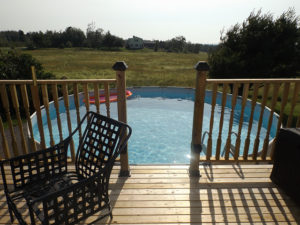According to the Centers for Disease Control and Prevention, there were 3,536 unintentional, non-boating related drownings annually from 2005 to 2014. You may think you are safe at home, but if you have a pool, you must be extra cautious. There were about 10 drownings a day, and one in five people who drown are age 14 and younger.

Drownings are one of the leading causes of unintentional injury-related deaths in children. You may want to have a childproof cover on your pool or a locked gate to fence in the pool. (Flickr / Creative Commons / Evan Goodwin)
This is why it is crucial to take safety precautions to prevent drownings in one’s swimming pool. Drowning in a pool can cause brain damage. It is the leading cause of death aside from birth defects for children age one to four. Most drownings happen in a pool at home. Children ages one to three are at the greatest risk.
Children younger than 15 have drowning as the second leading cause of unintentional, injury- related death. For every child who dies, ten more end up in the emergency room for non-fatal injuries like brain damage. In these non-fatal cases, oxygen is deprived to the body, and bodily functions begin to shut down. In children, this can happen in a matter of seconds.
However, one may be revived even if they are underwater for a long time. One of the leading causes of drowning is leaving children unattended. This is why it is vital to supervise children while they are in the pool. It also can’t hurt to learn CPR in case the child needs to be revived on the spot before first responders arrive. Contact your local fire department or hospital for class information.
If you are supervising a child, do not talk on the phone, text, read, or do anything that might distract you from saving the child. For children preschool or younger, it’s important to stay very close to the child, so you may save them in one to two seconds. Again, the perilous effects of being deprived of oxygen can happen in children in a matter of seconds.
It is important to have an adequate fence around the pool. A chain link fence can be too easily climbed. Also remember to move any tables or ladders that the child may climb on the enter the pool area. The fence must be at least four feet high and located three feet away from the pool.
You may also want to consider a pool alarm. Or you can use a child-proof pool cover to cover the pool completely, so that a child may not enter the pool. Make sure that pool fences close and lock automatically and the lock is located out of reach of young children.
The pool drain may also have a suction that can pull the child down to the bottom of the pool. Make sure that there is no suction on the pool drain. Also make sure that the drain is covered by an anti-entrapment cover.
Hopefully these tips will help you make your home pool a safer place for the family to have fun without the danger of drowning. Prevention is key to avoid the effects of brain damage and death that occur after drowning or near drowning.

